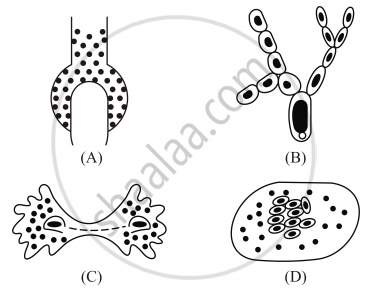Advertisements
Advertisements
Question
Label the parts (1) and (2) in budding of yeast cell.

Solution
- Parent cell
- Bud
APPEARS IN
RELATED QUESTIONS
What happens when a Planaria gets cut into two pieces?
Name one organism which reproduces by spore formation
What care should be taken while making a cutting from a plant?
One of the following organisms does not reproduce by fission. This is :
(a) Amoeba
(b) Leishmania
(c) Planaria
(d) Plasmodium
The stem of a fruit tree X fixed in soil is cut in a slanting way. The upper part of stem of another fruit tree Y of different variety of same species is also cut in a slanting way. The cut stem of tree Y, without roots but having some leaves, is placed over the rooted cut stem of tree X in such a way that their cut surfaces fit together properly. While joining the two cut stems, care is taken to make sure that the layer Z of one cut stem is in contact with layer Z of the other cut stem. The joint of cut stem is bound tightly with a piece of cloth and covered properly with polythene. Soon the cut heals and the two stems grow together and become one fruit tree producing leaves, flowers and fruits.
(a) What is the name of this method of producing plants or trees?
(b) What name is given to the cut stem of tree X having roots?
(c) What name is given to the cut stem of tree Y which has no roots but has some leaves?
(d) Name the layer Z.
(e) Why should the layer Z of one cut stem be in contact with the layer Z of the other cut stem?
(f) Name any four fruit trees which are usually bred by this technique.
(g) State any one advantage of producing fruit trees by this technique.
A worm X found in freshwater and slow-moving streams has been accidently cut into three pieces. It was observed that in due course of time, each cut piece of the worm develops to become a complete worm by growing all the missing parts.
(a) Name the worm X which can exhibit this phenomenon of making complete worm from its cut body parts.
(b) Name another organism Y which possesses the same characteristic of growing fully from its cut body parts.
(c) What is the name of this process in which a complete organism is formed from its cut body part.
(d) State whether X and Y are unicellular and/or multicellular organisms.
(e) Can a dog be produced completely form its cut body part (say, a cut tail) just like organisms X and Y? Why?
Write a short note on Vegetative reproduction.
Binary fission is observed in which one of the following figures?

The asexual reproduction in bacteria occurs by ______.
Length of pollen tube depends on the distance between
